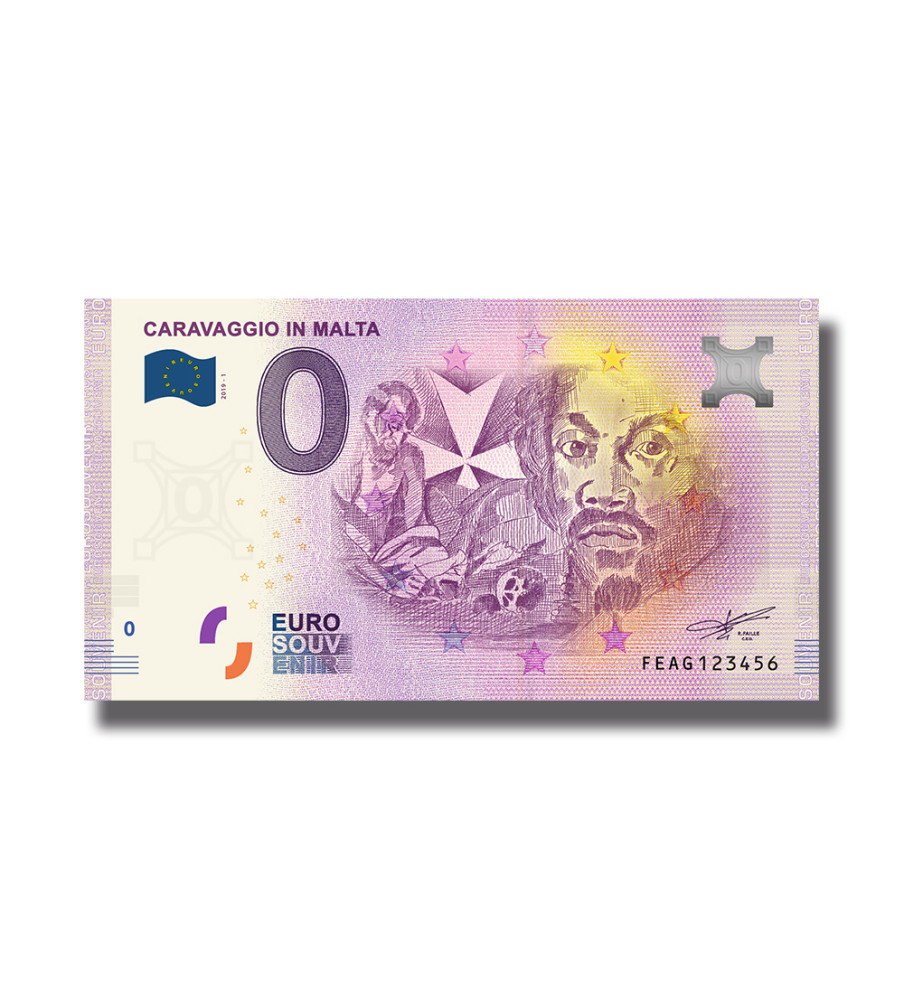


Plus de 5 000 objets de collection différents, achetez en toute confiance
Plus de 5 000 objets de collection différents, achetez en toute confiance
0 Euro Souvenir Banknote Caravaggio In Malta 2019
Official Souvenir Banknote
Issue Date April 2019
When ordering before the issue date, delivery will be made at a later date when the banknote is issued.
Michelangelo Merisi was born in the town of Caravaggio (about 30 kilometres from Milan) in 1571. Caravaggio was, in fact, the first great representative of the Baroque movement. He was the archetypal rebellious artist and led a turbulent life. His life, it is said, matched the high-drama of the chiaroscuro style that his paintings became famous for.
In 1606 whilst working in Rome, one of his many brawls resulted in Caravaggio killing a young man called Ranuccio Tomassoni. With a price on his head, Caravaggio fled and headed for Naples where he would be outside the Roman jurisdiction and under the protection of the Colonna family. After just a few months, despite a successful period in Naples where he was given a number of important church commissions, Caravaggio left for Malta, the headquarters of the Knights of the Order of St John of Jerusalem, arriving on the island in July 1607.
Portrait of Alof de Wignacourt, the Grand Master of the Knights of Malta. Caravaggio
Grand Master Alof de Wignacourt invested Caravaggio as a knight of magistral obedience so taken was he at having an artist of such calibre as official painter of the Order. It was during this time that Caravaggio was commissioned to paint ‘The Beheading of St John the Baptist’ and ‘St Jerome Writing’, both of which are on display in St John’s Co-Cathedral. This period of relative calm in his life was short lived, and by late August 1608, Caravaggio was arrested for causing trouble once again, this time badly wounding a high ranking Knight in another fight. Imprisoned at Fort St Angelo, disgraced and unable to paint, he used his inventive powers to plan his escape. Caravaggio’s incredible break-out took place in October 1608 and once again he was on the run. The Council, informed of his escape, immediately expelled him from the Order.
The Beheading of Saint John the Baptist (1608)
St. John’s Co-Cathedral
After a nine month stay in Sicily, during which time he was trying to secure a pardon from Pope Paul V, Caravaggio returned to Naples and the protection of the Colonna family. His style and technique as an artist was still evolving and he enjoyed a productive time in his second spell in Naples. An attempt was made on his life, and an incorrect account of his death was reported in Rome. Although Caravaggio survived the attempt, his face was left seriously disfigured.
In an attempt to build bridges, Caravaggio painted ‘Salome with the Head of John the Baptist’. He depicted his own head on the platter and sent the work to de Wignacourt as a plea for forgiveness.
In 1610, Caravaggio took a boat north to receive a pardon, thanks to powerful allies in Rome. What happened then is shrouded in mystery. The artist was reported as dead in a private newsletter (an avviso) dated 28th July. Three days later, another newsletter declared that the artist had died of fever. His body, however, was never found.
Michelangelo Merisi was born in the town of Caravaggio (about 30 kilometres from Milan) in 1571. Caravaggio was, in fact, the first great representative of the Baroque movement. He was the archetypal rebellious artist and led a turbulent life. His life, it is said, matched the high-drama of the chiaroscuro style that his paintings became famous for.
In 1606 whilst working in Rome, one of his many brawls resulted in Caravaggio killing a young man called Ranuccio Tomassoni. With a price on his head, Caravaggio fled and headed for Naples where he would be outside the Roman jurisdiction and under the protection of the Colonna family. After just a few months, despite a successful period in Naples where he was given a number of important church commissions, Caravaggio left for Malta, the headquarters of the Knights of the Order of St John of Jerusalem, arriving on the island in July 1607.
St. John’s Co-Cathedral
After a nine month stay in Sicily, during which time he was trying to secure a pardon from Pope Paul V, Caravaggio returned to Naples and the protection of the Colonna family. His style and technique as an artist was still evolving and he enjoyed a productive time in his second spell in Naples. An attempt was made on his life, and an incorrect account of his death was reported in Rome. Although Caravaggio survived the attempt, his face was left seriously disfigured.
In an attempt to build bridges, Caravaggio painted ‘Salome with the Head of John the Baptist’. He depicted his own head on the platter and sent the work to de Wignacourt as a plea for forgiveness.
In 1610, Caravaggio took a boat north to receive a pardon, thanks to powerful allies in Rome. What happened then is shrouded in mystery. The artist was reported as dead in a private newsletter (an avviso) dated 28th July. Three days later, another newsletter declared that the artist had died of fever. His body, however, was never found.